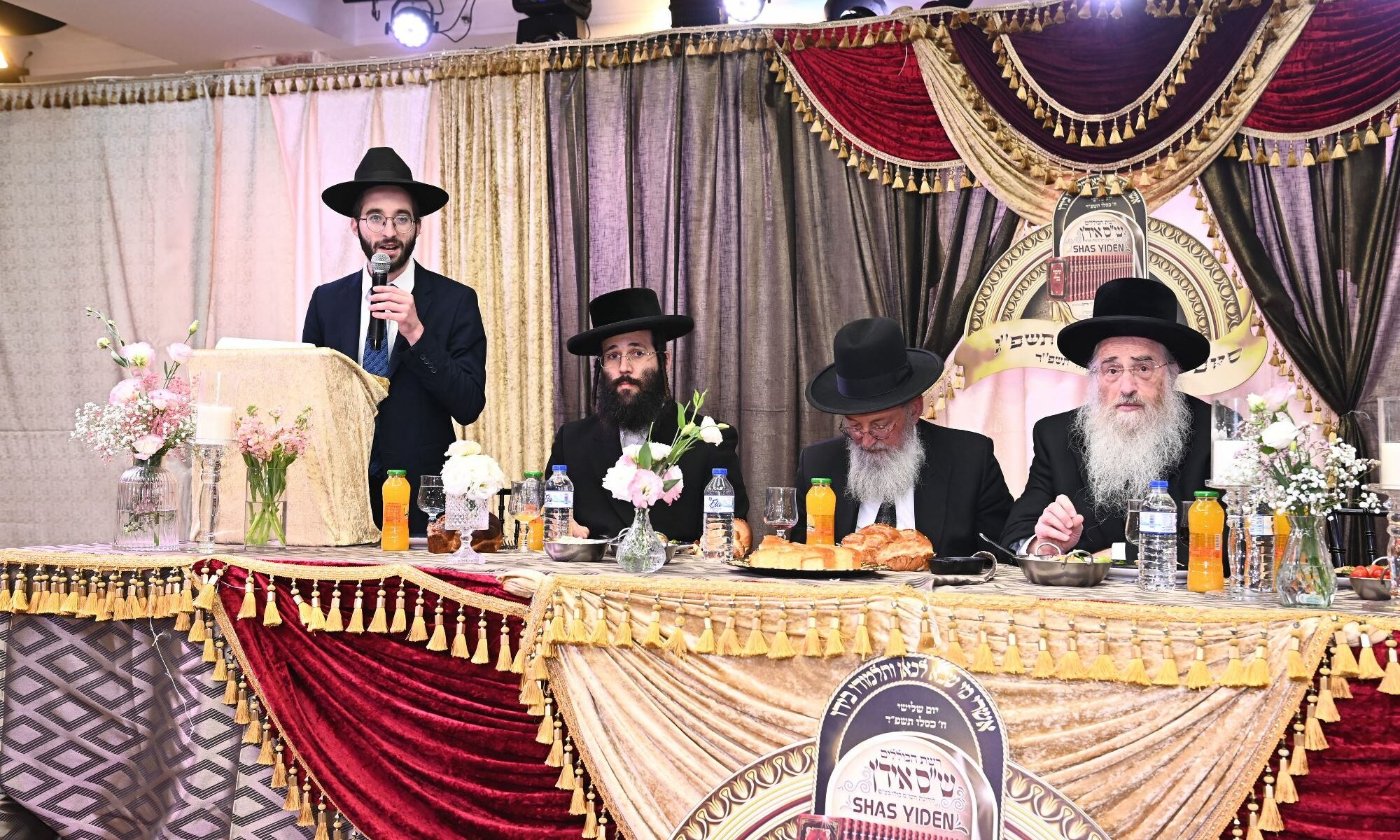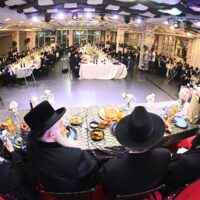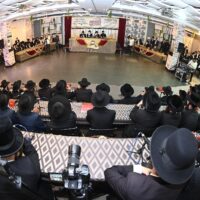The Secret of the Sparkling Eyes
Shas Yiden geonim being tested, ‘firing’ answers at a blinding rate
Kislev 5784 – The Pavilion Hall, Yerushalayim. The Shas Yiden Kolel Network under the leadership of the Pozna Rov, Hagaon Harav Avrohom Halevi Eisen, shlit”a, conducts a public farher on the entire Shas.
Something in the lighting of the hall ‘seemed to be different’. While we are used to various effects, but never sparkling eyes of the people on the stage. So how are their eyes sparkling so? How can one ask them? To interrupt them from their Torah learning, just to ask them?
Even in the minutes before the beginning of the farher, the candidates are all sitting on the stage and reviewing Talmud. They just don’t waste a minute. In front of each is a microphone which will soon carry their answers. To try and find someone who is sitting idle? There is no likelihood of that.
That’s just how it is! Anyone who can find that he has free time is not one who can learn, review and be tested on the entire Shas. The concept of utilizing time, down to the minute, appears to be embedded in their DNA! These are people who, even when standing in a bus, have a sefer in their hands and are learning, all the more so, when they are sitting in optimal conditions as at the Pavilion Hall, they will not waste a minute …
The Two Examiners Enter the Hall
They are: Maran Hagaon Harav Chaim Peretz Berman, shlit”a, Rosh Yeshiva of Ponevez, and Maran Hagaon Harav Yisroel Bunim Schreiber, shlit”a, Rosh Yeshiva of Nesiv Hadaas.
At the one end of the hall is a group of ‘American looking’ young men – sons of Shas Yiden supporters and donors and their young yeshiva friends. A few of them “looked and were ‘smitten’. They had attended a Shas Yiden farher and ‘were bitten’ by the Shas learning bug and had committed themselves to learning Shas. As for joining the family business back home in the USA, they gave heed to the saying “מרבה נכסים מרבה דאגה” (Gathering possessions increases worries) and left that to their brothers …
From the Farher – Harav Chaim Peretz Berman
Rav Chaim Peretz informs the avreichim that his initial questions will incorporate elements from the weekly Parsha (portion), raising concepts/subjects from the Parsha and the Shas Yiden were to say where and in what context are they found throughout Shas. Well, even before he manages to finish asking any of the questions, the answers come thundering in response, and he looks out at all the avreichim and smiles.
It is as if that until now we knew that “שאלת חכם חצי תשובה” (the question of a wise person is half the answer), here at the farher, we found out that “תשובת חכם חצי שאלה” (the answer of a wise person is half the question)… In an instant, the amazing avreichim realize the direction of the question, and call out the answer – the masechta, the blatt, and the דיבור המתחיל of Tosfos where it is to be found! From time to time, the questions are enigmatically spiced up, such as where and concerning what is there a dispute between Reb Chaim and Reb Chaim?
To enable the farher to run smoothly, the avreichim from each of the 5 kolelin in Eretz Yisroel are sitting together and, prior to each question, it is addressed to kolel A or B etc. Even so, all the avreichim of that particular kolel will burst out with the answer. And what about the concept “תרי קלי לא משתמעי” (two voices answering simultaneously cannot be heard properly)? We know ‘that which is preferred, is in fact heard above the others.’
The following question: What are the different shittos (approaches) regarding Kiddush & Havdalah… And the answers are given at a dizzying pace: all mnemonics – “יקנ”ה! ינה”ק! קני”ה! קינ”ה! נקי”ה! ניה”ק! יקזנ”ה! יקנה”ז! Don’t think that this is a computer memory. Not at all. This is also not AI – artificial intelligence. Many of the questions require human reasoning, that reasons out in a way that a computer cannot. This is a result of laboring for many years, clarifying and distilling, laboring and reviewing.
From the Farher – Harav Bunim Schreiber
The questioner’s baton (the microphone) is passed to Rav Bunim, who immediately begins raining down sharp and tough questions on the Shas Yiden. Rav Bunim is well-known as someone who inspires young avreichim to study with an orderly program to acquire knowledge throughout the entire Shas. His questions are colorful and unexpected.
“What are the 18 items that they decreed?” The answers are like incessant, exploding thunder. And if a question appears to be very broad, the next is very deep. The avreichim are asked how many approaches are to be found in a particular sugya of the Talmud. To answer correctly and on the turn, one has to take into account no less than eight blatt.
“How many disputes are there between Beis Shammai and Beis Hillel in masechta Beitzah? The answers begin flowing, but then Rav Bunim interrupts them: “Actually, what difference does it make how many? Rather, what are the disputes between Beis Shammai and Beis Hillel in masechta Beitzah? And again, the answers come gushing forth.
“What are the 21 items that their Mitzvah applies only in the daytime?” What are the differences applying to a mourner, one in חרם (who is excommunicated), and a leper? How many cases of מלקות (lashes) are there?” Again, a juicy one – In the Rambam it is noted there are 207.
At the conclusion of the farher it turned out that the number of questions put forward by Rav Bunim, was that of the number of masechtas in Shas – each corresponded to a particular masechta. Moreover, he consulted no notes of his questions – all were committed to memory!
And when Rav Bunim descended from the dais, one avreich went over to him and asked for a word of chizuk about life. Rav Bunim responded on the spot, ‘learn and learn – that is the essence of real life!’
Amazing Joy
One of the attendees asked, “Did you notice what was the common denominator of all the Shas Yiden sitting in the three rows across the stage?” He glanced quickly and said, “The joy that can be seen on all of their faces and in their sparkling eyes.” Was there a security guard allowing only happy avreichim to enter?
Rav Bunim commented immediately: Maran Harav Yechezkel Abramsky, zt”l, said “It is written that “תלמידי חכמים מרבים שלום בעולם” (Talmidei chachomim bring about much peace in the world). What does this mean? How does this work? Very simple: the beginning of any dispute is rooted in the fact that someone is not happy or is dis-satisfied. When a person is not satisfied, he makes sure that his surroundings are also not satisfied…
However, talmidei chachomim are satisfied. It is good for them through the Torah that they learn. Thus, around them things and the atmosphere are good and, thus, they bring about peace in the world. What kind of Talmid Chacham is satisfied and has good? Mishlei (15:23) establishes that joy is located “בְּמַעֲנֵה פִיו”. A Talmid Chacham who has his learning clear, he is a joyous and happy person!
Trying to Trash His Laptop
Hearing these words clarified an incident at a previous Shas Yiden farher. An askan from one of the Shas Yiden kolelim noticed out of the corner of his eye, that a journalist who had once learned in yeshiva, was busy at a garbage bin at the end of the hall. To his amazement, the journalist appeared to be trying to trash his laptop! Apparently, he had been overcome by the prowess of the Shas Yiden avreichim geonim that he had just witnessed, and was readying himself to change his life and to ‘jump into the waters of the Talmud’ and to devote himself to study Shas…
One of the attendees commented, “I concede that I am not on the level of that journalist, but I am still sensitive enough not to even attempt to interrupt the Shas Yiden from their learning, even if just to ask them a question or two. This, even though I really, really wanted to get to know them and ascertain the secret of their sparkling eyes. They had gathered here at the Pavilion from far and near and here they were like one tight unit. I am certainly not the one to try come between them!”
So, the same individual found a place on the side, and waited patiently to ‘hunt down’ a Shas Yid who would walk by before the banquet to a washing station, with the thought that he will use the couple of minutes to hear something…
Words from Shas Yid-1
And behold a pair of sparkling eyes… Harav Betzalel Blau, shlit”a, and he asked him in a convoluted manner: “Here you are already eating the fruits of your investment. Everything is nice, everything is shining and sparkling… But how do you overcome all the difficulties or challenges which are surely to be found in the way of somebody who wants to know the entire Shas?”
Rabbi Blau: “Who does not find it difficult? Everyone finds it challenging! Do you know what it was customary to say in Yerushalayim? Easy is only in the grave… There’s nothing easy in life, the only question is what is a person’s aim or direction? And where will his challenges be? A person who gets to know Shas becomes a different person – he eats differently, he breaths differently, his energy is different – and that makes all the difficulties worthwhile. There was one at our Shas Yiden kolel who couldn’t cope with the study load and demand, and decided to leave. When one of the avreichim heard of the departure, he asked me in consternation: “But how is he going to continue living?”
“My Sabba (grandfather), Hagaon Reb Aharon Yeshaya Blau, shlit”a, who will be here shortly, said that at the age of 42 he began learning Shas in its codified order. Before that he was busy with preparing shiurim. And he has been encouraging his grandchildren to embark on learning Shas from the age of 20… Sabba always repeats the following: “Believe me, with all that I have gone through in my life, there’s nothing sweeter than the learning of a page of Gemora with Rashi and Tosfos. However, if we become accustomed from a young age that the real geshmak (pleasure) is only b’iyun … It’s true that there is a special geshmak in learning in depth and lomdus, but if one does not become accustomed to draw the geshmak from knowing another blatt and another blatt, another masechta and another masechta then… “
Did you have difficult moments during the years?
“Certainly, there are moments when a person stands confronted by a big challenge and asks: Who says that I will succeed? But “אין דבר העומד בפני הרצון” (there is nothing that stands before one’s will to succeed). It’s only the beginning that is difficult, because as things continue, one finds Siyata Dismaya (help from Above) from different directions and overcomes the challenges.
Last comment…
“My Sabba is no longer young, but he says that the moment he begins to delve into a blatt of Gemora, he forgets all his problems. And this, in short, is what each one of us experiences in the Shas Yiden network.”
Words from Shas Yid-2
The next sparkling eyes belonged to Harav Menashe David, shlit”a. When he heard the reference to the sparkling eyes, he could not hide his smile, not to say his laugh. He recalled: When I returned from the Shas Yiden kolel the first time after my wedding, my wife said; “Your eyes are sparkling today more than the day of our wedding…”
And what happened thereafter?
“If one’s already writing about the subject, in truth it’s important to consider it seriously. In the Shas Yiden kolel you find yourself on a conveyor belt that grinds away and wears one down. In order to stop the burn out, I took upon myself, bli neder, that at the at the siyum of a masechet to celebrate above and beyond what I would normally do – a seudah with good food, joyous dancing, etc.
There were already occasions, when for various personal reasons, I had the task of personally preparing the siyum meal from beginning to end, which was my honor – there is no embarrassment to put one’s hands in cold water. I knew that the previous siyum gave the impetus to learn this last masechta, and the current one for the next – an approach good for all studying Shas.” There are many times when the Shas Yiden celebrate in their particular kolel.
What about a short masechta like Horayos?
No, not just after 14 blatt. However, at Shas Yiden we are tested on 225 blatt a month! So, one can even arrange a couple of siyumim simultaneously. The regimen requires us to complete 9 blatt a day (with four revisions of each) and 4 blatt (and 4 revisions) on Erev Shabbos and Shabbos).
And what prevents burn out between one siyum and the next?
“There’s no time for burn out. In a Shas Yiden kolel it is impossible to goof off, let alone doze off. When you are studying Shas again and again, what you examine on the same page is not necessarily the same each time.
Rather, each time you delve in a different way. When you study the same blatt for the eighth time you may discover that everything that you learned can, in fact, be learned the other way around! You then discuss this analysis with your chavrusa (study partner) and very quickly you may turn the entire kolel into a fiery scholarly debate. This enables different observations in agreement or in contradiction. Thus, every day there is something new or a new angle…”
You are saying something contradictory:
Not only is it not fatiguing to review again and again, rather it makes it much more dynamic and interesting! “Clearly! Every day a potential ‘war’ can break out between the avreichim on how to study or ‘pull apart’ a particular section…”
An Avreich leaves
Over the years were there avreichim that left the framework of this demanding regimen? “I remember one particular avreich who left and went to become a Rosh kolel.” And were any of the other avreichim jealous of his change? “Yes and yes.” What does that mean? We are jealous of him, he has a prestigious position; and he’s jealous of us that we have remained in this particularly amazing and dynamic Torah framework.
Final question:
You already know Shas. What is your motivation and desire to achieve? “With all due respect your question is laughable. Do you know what it means to know Shas? That’s really an expression that should not ever be used because it does not make sense.
For example: A week ago, we found that Rabbi Akiva Eiger asked the same question asked by Tosfos centuries before. No, this was not possible. To know Shas means that you have a clear answer to this question and to thousands of similar questions – these are waters that have no end.















